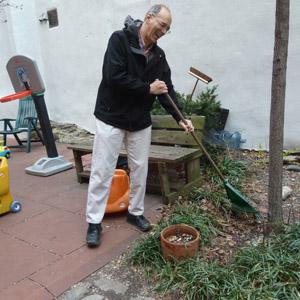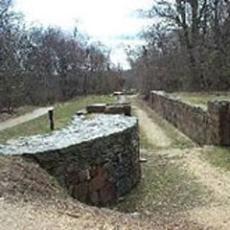FAITH LAPIDUS: Welcome to AMERICAN MOSAIC in VOA Special English.
(MUSIC)
I'm Faith Lapidus. This week, on our program we play new music from Alison Krauss and Union Station...
answer a question about the Patowmack Canal near Washington...
but first we visit some New York City gardeners and their green spaces...
(MUSIC)
Community Gardens
FAITH LAPIDUS: You have probably heard the term "concrete jungle." People use it to describe big cities that often have more hard surfaces than green space. Some people call New York City a concrete jungle. But, New York is also home to hundreds of community gardens filled with all kinds of crops. Bob Doughty has our story.
BOB DOUGHTY: It is almost 9:00 in the morning on a workday. And Noah Kauffman is working hard, but not at his paying job. He is digging in the soil at the 113th Street Play Garden in Manhattan. He is the volunteer president of the community garden.

NOAH KAUFFMAN: "New York City is, if anything, the built environment. We have plenty of concrete. We have plenty of bricks. We have plenty of steel. We have little, little places like this vest pocket park, which are a small oasis, a piece of green. For our neighbors here on 113th Street, this is our front yard and we share it."
For Alexandra Patz and her seven year old son, the garden has been a refuge since they moved to New York. They had come from a town where they had a home with a backyard.
ALEXANDRA PATZ: "When we moved to the city, I was glad to find on this block that there was a little garden where we could become involved, where my son could experience digging and growing things. He's outside. We can hear the birds tweeting. You know, he's sitting under a tree. There are no leaves yet, but you know, they're coming. There are little birds digging and in the dirt there, you know...Life!" [LAUGHS]
New York City has more than 500 community gardens. The movement to create them began in the 1970s. It was a difficult time. The city's population was falling and many empty outdoor areas were filled with waste and rats.
New York began its Operation Greenthumb program in 1978. The program offers free crop growing classes and some gardening equipment. Yet economics can sometimes get between the gardeners and their gardens. City officials have successfully fought to re-gain control of some areas so they could sell the land to property developers.
Catherine Wint is a community garden organizer with the New York Land Trust. She and other organizers collect money to buy green space in the city. Then they surrender ownership of the land to the people in the community.
Catherine Wint says volunteers supervise and care for the gardens. She says these individuals bring their own plans, values and leadership styles.
CATHERINE WINT: "It's different than a park, in that sense, because individuals in a community garden have to have a relationship and they have to work democratically and they have to come up with procedures to enable them to share this very small space in a way that's going to benefit everyone."
However, these individuals also create gardens that are unusual because of their mix of plants. A Mexican immigrant family working in one garden plants a species of red pepper commonly used in Mexican food. Next to that crop are peony flowers planted by a Chinese immigrant who misses his homeland.
Community gardener Lori Harris looks at the green space that her now 90-year-old father helped create in Harlem. It was a trash-filled lot when he started working on the project in 1971. Lori Harris is proud as she talks about the true success of the garden.
LORI HARRIS: "You have to give back to Earth. You can't just take everything from it. You've got to learn how to recycle and clean up. You know, people think groceries come from the grocery store, but they come from a farm. They start somewhere. So you really have to treat Mother Earth right and she treats you just the same. [LAUGH]"
Patowmack Canal
FAITH LAPIDUS: Our question this week comes from the American island territory of Puerto Rico. Leidyonor Muniz Quinones wants to hear about George Washington's Patowmack Canal.
The Patowmack Canal is part of Great Falls National Park in Virginia, about 25 kilometers from Washington. The Patowmack was one of the first canals built in the United States.

The idea for the canal came from George Washington, now known as the father of the country. He had explored the area around the Upper Potomac River. He believed that that the river had to be made passable by boats. He thought the waterway would be a great path of trade between the east coast and western territory.
However, the Potomac River is very wild. Its Great Falls area is famous for powerful currents that flow sharply downhill. The river falls almost 25 meters in less than 1.5 kilometers. The water is filled with huge rocks above and below the surface.
Washington knew a canal would have to be built for boats to safely pass by Great Falls. He also knew the project would be a long and costly process.
George Washington was a very popular leader at this time. He had commanded the Continental Army in America's successful fight for independence from Britain. He was known as a wealthy farmer and land expert. As a result, he easily won financial support for the canal. He set up the Patowmack Company and started building the canal in 1785.
George Washington led the project until he took the office of President in 1789. But building continued.
It took 17 years to complete the Patowmack Canal. It included a series of locks. The locks raised or lowered the water in the canal to permit the boats to pass by the dangerous falls.
Thousands of boats travelled the Patowmack Canal. They carried flour, alcohol, cloth, weapons and other goods. However, the water levels in the river made the canal usable only about two months out of the year. And profits never covered the cost of the building project. In the end, the Potowmack Company failed. The canal operated for only about 25 years.
The Patowmack Canal is now dry. It is open to visitors every day from 7:00 in the morning until dark. The canal's lock structures are still observable. The powerful Great Falls that made the canal necessary are also an extraordinary sight.
(MUSIC)
"Paper Airplane"
FAITH LAPIDUS: Bluegrass singer Alison Krauss has been making records since she was 14 years old. The 39 year old performer has also won 26 Grammy awards for her music. Recently, she reunited with Union Station, the group with which she has made several recordings over the years. Katherine Cole has music from Alison Krauss and Union Station's new album "Paper Airplane."
(MUSIC)
KATHERINE COLE: That was Alison Krauss singing "Miles to Go." Like most songs on the album "Paper Airplane," this one is about the difficult emotions of failed love.
Krauss says "Paper Airplane" was one of the most difficult albums she has ever made. She suffered severe headaches that affected her ability to give her full attention to the music. She and Union Station decided to take a break from recording so that she could rest and recover.

Here is Union Station band member Dan Tyminski singing "Dust Bowl Children." It is about living through hard times and poverty.
(MUSIC)
Alison Krauss says she and her band realized while recording this album that they could not depend on their past methods of making music. Instead, she said, they worked together to make music they found to be deeply truthful and moving. She says the songs on this album are sad, but they feel good because they are honest. We leave you with "Lie Awake."
(MUSIC)
FAITH LAPIDUS: I'm Faith Lapidus. Our program was written by Dana Demange and Caty Weaver, who was also our producer.
If you ever miss a program, or want to search for subjects that interest you, go to voaspecialenglish.com. You can download transcripts and MP3s of all of our shows.
You can also send us questions about American life. Go to the Contact Us link at the bottom of the page or write to mosaic@voanews.com. And we're on Facebook and Twitter at VOA Learning English.
Join us again next week for music and more on AMERICAN MOSAIC in VOA Special English.
Beauties in the garden: growing ornamental trees and bushes
Grow it yourself: turning bulbs into beautiful blooms
Celebs at the 51st annual Grammy Awards in Los Angeles
(来源:VOA 编辑:崔旭燕)
